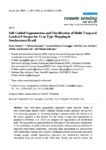Please use this identifier to cite or link to this item:
http://www.alice.cnptia.embrapa.br/alice/handle/doc/1034915| Title: | Self-guided segmentation and classification of multi-temporal landsat 8 images for crop type mapping in southeastern Brazil. |
| Authors: | SCHULTZ, B.  IMMITZER, M.   FORMAGGIO, A. R.   SANCHES, I. D. A.   LUIZ, A. J. B.   ATZBERGER, C.   |
| Affiliation: | BRUNO SCHULTZ, INPE; MARCUS IMMITZER, University of Natural Resources and Life Sciences, Viena; ANTONIO ROBERTO FORMAGGIO, INPE; IEDA DEL'ARCO SANCHES, INPE; ALFREDO JOSE BARRETO LUIZ, CNPMA; CLEMENT ATZBERGER, University of Natural Resources and Life Sciences, Viena. |
| Date Issued: | 2015 |
| Citation: | Remote Sensing, Basel, v. 7, n. 11, p. 14482-14508, 2015. |
| Description: | Abstract: Only well-chosen segmentation parameters ensure optimum results of object-based image analysis (OBIA). Manually defining suitable parameter sets can be a time-consuming approach, not necessarily leading to optimum results; the subjectivity of the manual approach is also obvious. For this reason, in supervised segmentation as proposed by Stefanski et al. (2013) one integrates the segmentation and classification tasks. The segmentation is optimized directly with respect to the subsequent classification. In this contribution, we build on this work and developed a fully autonomous workflow for supervised object-based classification, combining image segmentation and random forest (RF) classification. Starting from a fixed set of randomly selected and manually interpreted training samples, suitable segmentation parameters are automatically identified. A sub-tropical study site located in São Paulo State (Brazil) was used to evaluate the proposed approach. Two multi-temporal Landsat 8 image mosaics were used as input (from August 2013 and January 2014) together with training samples from field visits and VHR (RapidEye) photo-interpretation. Using four test sites of 15 × 15 km2 with manually interpreted crops as independent validation samples, we demonstrate that the approach leads to robust classification results. On these samples (pixel wise, n ? 1 million) an overall accuracy (OA) of 80% could be reached while classifying five classes: sugarcane, soybean, cassava, peanut and others. We found that the overall accuracy obtained from the four test sites was only marginally lower compared to the out-of-bag OA obtained from the training samples. Amongst the five classes, sugarcane and soybean were classified best, while cassava and peanut were often misclassified due to similarity in the spatio-temporal feature space and high within-class variabilities. Interestingly, misclassified pixels were in most cases correctly identified through the RF classification margin, which is produced as a by-product to the classification map. |
| Thesagro: | Sensoriamento remoto |
| NAL Thesaurus: | Remote sensing Brazil |
| Keywords: | Mapeamento agrícola Segmentação multirresolução OBIA Crop mapping Multi-resolution segmentation OLI Random forest |
| ISBN: | http://dx.doi.org/10.3390/rs71114482 |
| Type of Material: | Artigo de periódico |
| Access: | openAccess |
| Appears in Collections: | Artigo em periódico indexado (CNPMA)  |
Files in This Item:
| File | Description | Size | Format | |
|---|---|---|---|---|
| 2015AP38.pdf | 5,67 MB | Adobe PDF |  View/Open |









